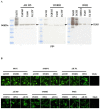Neuraminidase and hemagglutinin matching patterns of a highly pathogenic avian and two pandemic H1N1 influenza A viruses
- PMID: 20161801
- PMCID: PMC2820099
- DOI: 10.1371/journal.pone.0009167
Neuraminidase and hemagglutinin matching patterns of a highly pathogenic avian and two pandemic H1N1 influenza A viruses
Abstract
Background: Influenza A virus displays strong reassortment characteristics, which enable it to achieve adaptation in human infection. Surveying the reassortment and virulence of novel viruses is important in the prevention and control of an influenza pandemic. Meanwhile, studying the mechanism of reassortment may accelerate the development of anti-influenza strategies.
Methodology/principal findings: The hemagglutinin (HA) and neuraminidase (NA) matching patterns of two pandemic H1N1 viruses (the 1918 and current 2009 strains) and a highly pathogenic avian influenza A virus (H5N1) were studied using a pseudotyped particle (pp) system. Our data showed that four of the six chimeric HA/NA combinations could produce infectious pps, and that some of the chimeric pps had greater infectivity than did their ancestors, raising the possibility of reassortment among these viruses. The NA of H5N1 (A/Anhui/1/2005) could hardly reassort with the HAs of the two H1N1 viruses. Many biological characteristics of HA and NA, including infectivity, hemagglutinating ability, and NA activity, are dependent on their matching pattern.
Conclusions/significance: Our data suggest the existence of an interaction between HA and NA, and the HA NA matching pattern is critical for valid viral reassortment.
Conflict of interest statement
Figures





Similar articles
-
Characterization of pseudoparticles paired with hemagglutinin and neuraminidase from highly pathogenic H5N1 influenza and avian influenza A (H7N9) viruses.Virus Res. 2018 Jul 15;253:20-27. doi: 10.1016/j.virusres.2018.05.024. Epub 2018 May 31. Virus Res. 2018. PMID: 29859234
-
Reassortment and modification of hemagglutinin cleavage motif of avian/WSN influenza viruses generated by reverse genetics that correlate with attenuation.Acta Virol. 2006;50(4):243-9. Acta Virol. 2006. PMID: 17177609
-
Hemagglutinin and neuraminidase matching patterns of two influenza A virus strains related to the 1918 and 2009 global pandemics.Biochem Biophys Res Commun. 2009 Sep 18;387(2):405-8. doi: 10.1016/j.bbrc.2009.07.040. Epub 2009 Jul 15. Biochem Biophys Res Commun. 2009. PMID: 19615337 Free PMC article.
-
The genetics of highly pathogenic avian influenza viruses of subtype H5 in Germany, 2006-2020.Transbound Emerg Dis. 2021 May;68(3):1136-1150. doi: 10.1111/tbed.13843. Epub 2020 Sep 29. Transbound Emerg Dis. 2021. PMID: 32964686 Review.
-
Epidemiology, ecology and gene pool of influenza A virus in Egypt: will Egypt be the epicentre of the next influenza pandemic?Virulence. 2015;6(1):6-18. doi: 10.4161/21505594.2014.992662. Virulence. 2015. PMID: 25635701 Free PMC article. Review.
Cited by
-
Scotomas in molecular virology and epidemiology of hepatitis C virus.World J Gastroenterol. 2013 Nov 28;19(44):7910-21. doi: 10.3748/wjg.v19.i44.7910. World J Gastroenterol. 2013. PMID: 24307785 Free PMC article. Review.
-
Computational study of interdependence between hemagglutinin and neuraminidase of pandemic 2009 H1N1.IEEE Trans Nanobioscience. 2015 Mar;14(2):157-66. doi: 10.1109/TNB.2015.2406992. Epub 2015 Mar 2. IEEE Trans Nanobioscience. 2015. PMID: 25751873 Free PMC article.
-
NA proteins of influenza A viruses H1N1/2009, H5N1, and H9N2 show differential effects on infection initiation, virus release, and cell-cell fusion.PLoS One. 2013;8(1):e54334. doi: 10.1371/journal.pone.0054334. Epub 2013 Jan 22. PLoS One. 2013. PMID: 23349854 Free PMC article.
-
Matrix-M adjuvanted virosomal H5N1 vaccine confers protection against lethal viral challenge in a murine model.Influenza Other Respir Viruses. 2011 Nov;5(6):426-37. doi: 10.1111/j.1750-2659.2011.00256.x. Epub 2011 May 9. Influenza Other Respir Viruses. 2011. PMID: 21668670 Free PMC article.
-
Pseudotype-based neutralization assays for influenza: a systematic analysis.Front Immunol. 2015 Apr 29;6:161. doi: 10.3389/fimmu.2015.00161. eCollection 2015. Front Immunol. 2015. PMID: 25972865 Free PMC article. Review.
References
-
- Knipe DM, Howley PM. 2007. Field Virology, fifth ed., Lippincott Williams & Wilkins Immunology.
-
- Horimoto T, Kawaoka Y. Influenza: lessons from past pandemics, warnings from current incidents. Nat Rev Microbiol. 2005;3:591–600. - PubMed
-
- http://www.who.int/csr/disease/swineflu/en/. Accessed on 21 August, 2009.
-
- http://www.who.int/csr/disease/avian_influenza/country/en/.Accessed on 11 August, 2009.
Publication types
MeSH terms
Substances
LinkOut - more resources
Full Text Sources
Other Literature Sources
Medical
Miscellaneous

